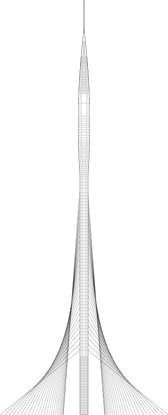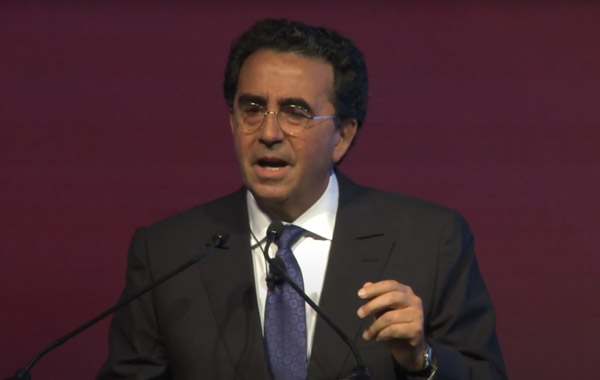Dubai Creek Tower
Dubai
- CTBUH Drawing
- Facts
-
Metrics
You must be a CTBUH Member to view this resource.
Architectural:
Height is measured from the level of the lowest, significant, open-air, pedestrian entrance to the architectural top of the building, including spires, but not including antennae, signage, flag poles or other functional-technical equipment. This measurement is the most widely utilized and is employed to define the Council on Tall Buildings and Urban Habitat (CTBUH) rankings of the "World's Tallest Buildings."
Official Name
Dubai Creek Tower
Other Names
Iconic Tower, The Tower, The Tower at Dubai Creek Harbour
Type
Supported-Tower
Status
On Hold
Country
City
Address
Function
A mixed-use tall building contains two or more functions (or uses), where each of the functions occupy a significant proportion of the tower's total space. Support areas such as car parks and mechanical plant space do not constitute mixed-use functions. Functions are denoted on CTBUH "Tallest Building" lists in descending order, e.g., "hotel/office" indicates hotel function above office function.
Observation
Structural Material
Both the main vertical/lateral structural elements and the floor spanning systems are constructed from steel. Note that a building of steel construction with a floor system of concrete planks or concrete slab on top of steel beams is still considered an “all-steel” structure as the concrete elements are not acting as the primary structure.
All-Concrete
Both the main vertical/lateral structural elements and the floor spanning systems are constructed from concrete which has been cast in place and utilizes steel reinforcement bars and/or steel reinforced concrete which has been precast as individual components and assembled together on-site.
All-Timber
Both the main vertical/lateral structural elements and the floor spanning systems are constructed from timber. An all-timber structure may include the use of localized non-timber connections between timber elements. Note that a building of timber construction with a floor system of concrete planks or concrete slab on top of timber beams is still considered an “all-timber” structure as the concrete elements are not acting as the primary structure.
Mixed-Structure
Utilizes distinct systems (e.g. all-steel, all-concrete, all-timber), one on top of the other. For example, a Steel Over Concrete indicates an all-steel structural system located on top of an all-concrete structural system, with the opposite true of Concrete Over Steel.
Composite
A combination of materials (e.g. steel, concrete, timber) are used together in the main structural elements. Examples include buildings which utilize: steel columns with a floor system of reinforced concrete beams; a steel frame system with a concrete core; concrete-encased steel columns; concrete-filled steel tubes; etc. Where known, the CTBUH database breaks out the materials used within a composite building’s primary structural elements.
All-Steel
Official Website
Height
828+ m / 2,717+ ft
Construction Schedule
Proposed
Construction Start
Developer
Architect
Usually takes on the balance of the architectural effort not executed by the "Design Architect," typically responsible for the construction documents, conforming to local codes, etc. May often be referred to as "Executive," "Associate," or "Local" Architect, however, for consistency CTBUH uses the term "Architect of Record" exclusively.
Structural Engineer
The Engineer of Record takes the balance of the engineering effort not executed by the “Design Engineer,” typically responsible for construction documents, conforming to local codes, etc.
MEP Engineer
The Design Engineer is usually involved in the front end design, typically taking the leadership role in the Schematic Design and Design Development, and then a monitoring role through the CD and CA phases.
Other Consultant
Other Consultant refers to other organizations which provided significant consultation services for a building project (e.g. wind consultants, environmental consultants, fire and life safety consultants, etc).
Other Consultant refers to other organizations which provided significant consultation services for a building project (e.g. wind consultants, environmental consultants, fire and life safety consultants, etc).
You must be a CTBUH Member to view this resource.
Developer
Architect
Usually involved in the front end design, with a "typical" condition being that of a leadership role through either Schematic Design or Design Development, and then a monitoring role through the CD and CA phases.
Santiago Calatrava Architects & Engineers
Usually takes on the balance of the architectural effort not executed by the "Design Architect," typically responsible for the construction documents, conforming to local codes, etc. May often be referred to as "Executive," "Associate," or "Local" Architect, however, for consistency CTBUH uses the term "Architect of Record" exclusively.
Structural Engineer
The Design Engineer is usually involved in the front end design, typically taking the leadership role in the Schematic Design and Design Development, and then a monitoring role through the CD and CA phases.
Santiago Calatrava Architects & Engineers
The Engineer of Record takes the balance of the engineering effort not executed by the “Design Engineer,” typically responsible for construction documents, conforming to local codes, etc.
MEP Engineer
The Design Engineer is usually involved in the front end design, typically taking the leadership role in the Schematic Design and Design Development, and then a monitoring role through the CD and CA phases.
Other Consultant
Other Consultant refers to other organizations which provided significant consultation services for a building project (e.g. wind consultants, environmental consultants, fire and life safety consultants, etc).
Other Consultant refers to other organizations which provided significant consultation services for a building project (e.g. wind consultants, environmental consultants, fire and life safety consultants, etc).
Fugro
NOVA Fluid Mechanics
CTBUH Initiatives
Top 12 Happenings of 2016, Month-by-Month
19 December 2016 - CTBUH News
Videos

21 October 2018 | Dubai
A Monument to the World: Dubai Creek Tower
The Dubai Creek Tower’s monumental design is influenced by the natural forms of the lily and evokes the shape of a minaret, a distinctive architectural...
Research

20 October 2018
Polycentric Cities: The Future of Vertical Urbanism
CTBUH 2018 Conference Speakers
As we approach the new normality of cities housing 10 million or more inhabitants, those best positioned for the future are evolving along polycentric, multi-nodal...
Global News
_Nick__Fewings__on__Unsplash.jpg)
31 August 2023
Dubai Creek Tower to Undergo Redesign
Emirates News Agency (WAM) reported that the Dubai Creek Tower is currently undergoing a redesign after a competition which saw several renowned international companies participate....
Research

20 October 2018
Polycentric Cities: The Future of Vertical Urbanism
CTBUH 2018 Conference Speakers
As we approach the new normality of cities housing 10 million or more inhabitants, those best positioned for the future are evolving along polycentric, multi-nodal...

20 October 2018
Towering Aspirations in Dubai and Beyond
Mohamed Ali Alabbar, Emaar Properties
In 2008, CTBUH held its Eighth World Congress in Dubai, at which time the world’s tallest building, the Burj Khalifa, was still under construction. His...
Subscribe below to receive periodic updates from CTBUH on the latest Tall Building and Urban news and CTBUH initiatives, including our monthly newsletter. Fields with a red asterisk (*) next to them are required.
View our privacy policy
















